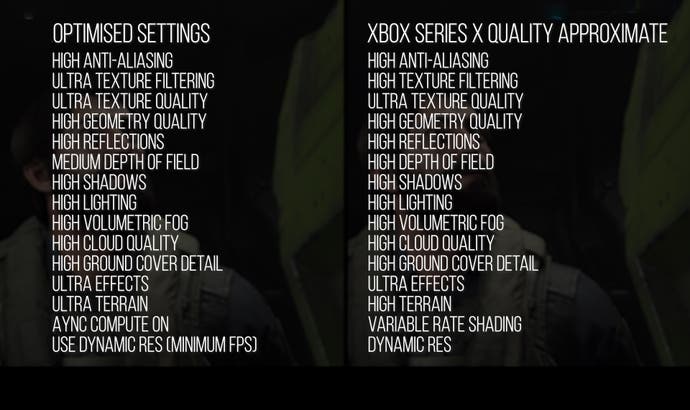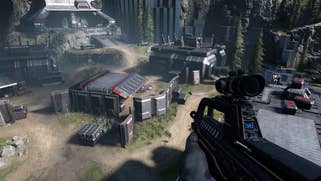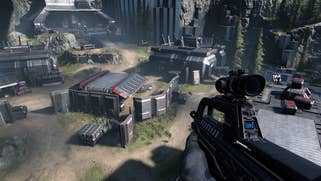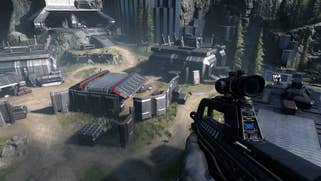Halo Infinite PC tested: best settings, performance analysis and Series X comparisons
It's a port that works - but still needs a lot of work.
Yes, it's a first-party exclusive and yes, it's going to sell a lot of Xbox Series consoles, but Microsoft's policy of delivering PC versions of its tentpole titles opens up Halo Infinite to massive range of gaming hardware. I'd characterise the quality of the PC conversion as variable: the game itself is brilliant and it is possible to have a great experience without owning an Xbox console.
That said, it's also fair to say that the PC version can be unexpectedly heavy on both CPU and GPU, there are many technical blemishes that need addressing, while 343 Studios fails to tap into any of next-gen features that work so well on modern PC set-ups - so there's no ray tracing (yet), no AI-based super-sampling and even variable rate shading (VRS) as seen on the console builds is totally absent on PC. What we have here is fine, but not exactly special and definitely needs a lot of work.
The first issue I spotted was on the title screen itself as soon as I booted the game. Just like the technical flights I looked at months back, Halo Infinite's implementation of v-sync and limiting frame-rate is flat-out broken. No matter how powerful your hardware, v-sync at 60fps drops frames - not that many, but enough to tell you something's up. Double up to 120fps and the frequency of the dropped frames increases to a more noticeable degree. It should be noted that the stutter is an issue even if you're using a FreeSync or G-Sync display.
Yes, you can turn off the in-built limiter and use the GPU control panel to fix this externally, but I have two points to make about that. Firstly, this is basic stuff that should have been fixed a long time ago - the user should not have to step in to override dodgy code. Secondly, a key feature for the game - dynamic resolution scaling - only works properly using the game's internal frame-limiting solution. If you use an external, working, frame-rate limiting solution, adjustments to resolution see the game move to its lowest possible resolution. This is a shame because you're effectively choosing between a visually compromised image, or else a DRS solution that gets the most out of your GPU at any given moment, but only if you can put up with the stutter.
Thankfully, the other settings in the game seem to work like they are supposed to and while there is some scalability in the game, I found that cumulatively, performance gains from optimised settings are more meagre than in many other titles and the extent of the gain can vary dramatically according to context. As is often the case, carefully assessing the quality vs performance of each and every setting reveals that console-equivalent settings often deliver the best for the buck, with Halo Infinite on Series X delivering a mixture of PC's high and ultra settings. In the table below, you'll see how my chosen settings stack up against the Xbox - and there's not much in it.
In terms of what each and every setting actually does to the presentation, that's all covered in extraordinary depth within the video. In terms of the settings that have the biggest impact to performance, that'll be cloud rendering and geometry quality, which pushes out draw distances. As usual, it's resolution that has the most profound impact - and the dynamic scaler is great in getting the most out of your GPU at any given point, but it only works properly with the broken frame-rate limiter, which is problematic.

What I can say for sure is that almost all of the technical issues John noted with the Series X built apply equally to the PC version - so these problems are definitely not related to GPU or CPU horsepower as such. So, cutscenes present with a jarring inconsistency in delivery, even when actual rendering performance is solid (something 343 says will be fixed in an upcoming patch). Meanwhile, facial animations are still running at 30fps, while the view weapon and Master Chief's hand have visible warping - but only in the open world. Curiously, the extent of this warping looks reduced on PC, which could perhaps be related to dynamic/lower resolution or VRS having an impact on Xbox Series X.
With optimised settings in place for graphics, the next aspect to worry about is CPU performance, where things get rough in the open world setting. The classic Ryzen 5 3600 seems to be good enough to deliver 60 frames per second, but ]there are some troublesome frame-time spikes during fast traversal with frame-rate unlocked. My main gaming rig features a Core i9 10900K, but even this has stutter problems and would not deliver a locked 120fps. Halo Infinite does feature other settings that are may improve CPU performance, such as changing the animation or world simulation rate, but I found no large change in frame-rate when adjusting these settings. Like most titles, your best bet for clawing back CPU performance will be geometry quality and shadows.














GPU-wise, Halo Infinite is a surprisingly heavy game as at 1440p, I found that the RTX 2060 Super and the Radeon RX 5700 could not deliver a locked 60 frames per second. There are also intriguing, but disappointing, anomalies in performance. Some situations see these closely matched GPUs operate to the same level of performance. However, moving into combat, the AMD card is faster, a situation that rises to a gulf of 17 percent as both cards tackle traversal through the open world at speed. This disparity seems broadly equivalent as you move through the GPU product stack, but can prove even wider - at one point, I noted my RX 6800 XT outperform the GTX 3080 by around 20 percent. I honestly believe both 343 and Nvidia really need to get to work here.
In general, my optimised settings are close to Series X quality mode, but reveal some truly rough spots on PC. For example, sometimes there are weird performance drops that come out of nowhere during cutscenes and cannot be explained by what's actually being rendered. I also had a situation during performance-testing the RX 5700 where reloading a level caused a gigantic performance drop, requiring me to quit and reboot to get that frame-rate back. Visual bugs including an occasional screen flash in the menus were also distracting. Ultimately, in a world where a 2060 Super or RX 5700 s only good enough for a locked 1080p60 on the closest we can get to Series X equivalent settings... well, that's certainly considerably off-pace compared to many other titles we've looked at in the new generation thus far and I'd hope for better to be honest.
There's the sense that general performance needs to improve then - but we need more. Obviously, the bugs need to be addressed, whether it's the cutscene stutter or the cut-back animation rates seen throughout the game. Getting the frame-rate limiter to actually lock to the targeted performance level is obviously a must. And lastly, an image reconstruction technique is a must. Perhaps DLSS is off the table since this is an AMD-supported title, but Intel's upcoming XeSS is more platform agnostic and should be implemented if possible. Ray tracing support? Absolutely. I think the point is that PC is such a forward-looking platform that it's natural to expect more from a mega-budget, high profile game like this one.
At the moment, I think it's clear that Halo Infinite could be better. It's playable and can scale beyond console visuals, but I for one will be holding back on playing the campaign through until the key issues are sorted, and where I can enjoy a smooth experience with the excellent dynamic resolution scaling implementation. In fairness, 343 has a history of responding positively to feedback and technical critiques, so fingers crossed that all of these issues will be remedied soon enough.









.jpg?width=291&height=164&fit=crop&quality=80&format=jpg&auto=webp)
